The Economics and Statistics Division maintains archives of previous publications for accountability purposes, but makes no updates to keep these documents current with the latest data revisions from Statistics Canada. As a result, information in older documents may not be accurate. Please exercise caution when referring to older documents. For the latest information and historical data, please contact the individual listed to the right.
<--- Return to Archive
For additional information relating to this article, please contact:
December 02, 2022LABOUR MARKET TRENDS, NOVEMBER 2022 Labour force survey results reflect the period from November 6-12.
Ages 15+ (November 2022 vs October 2022, seasonally adjusted)
Nova Scotia's seasonally adjusted employment increased 1,600 (+0.3%) from October 2022, rising to 482,500 in November 2022. This was not a significant employment gain.
The change in employment was attributable to full-time employment (+1,600) while part time employment was unchanged. These changes include variations in hours within the same job.
Nova Scotia’s labour force decreased by 2,100 (-0.4%) to 513,600 in November 2022.
With labour force contracting and employment rising, Nova Scotia's unemployment rate decreased from 6.7% in October 2022 to 6.0% in November 2022.
Nova Scotia's labour force participation rate was down 0.3 percentage points to 60.5% in November 2022. The employment rate was up 0.1 percentage points to 56.8% in November 2022.
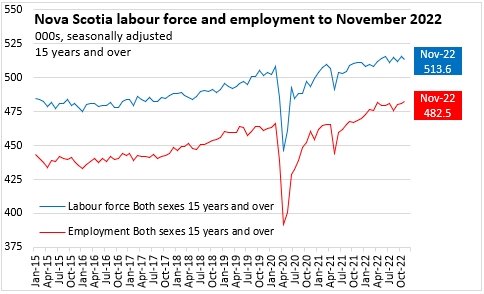

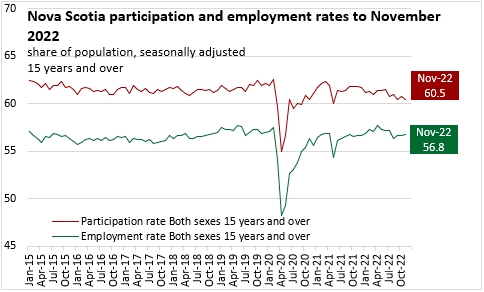
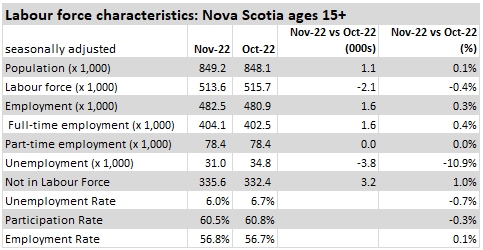
Ages 15+ (November 2022 vs November 2021, seasonally adjusted)
Compared with November of 2021, Nova Scotia's population over the age of 15 had increased by 22,600 (+2.7%) while the labour force grew by 2,600 (+0.5%) and employment increased by 13,800 (+2.9%). The unemployment rate decreased by 2.3 percentage points while the participation rate fell by 1.3 percentage points. The employment rate increased by 0.1 percentage points.
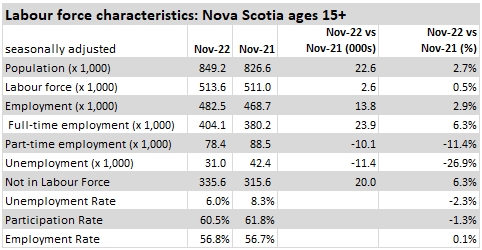
Ages 15+ (January-November 2022 vs January-November 2021, seasonally adjusted)
Compared with the first eleven months of 2021, Nova Scotia's population has averaged 18,700 (+2.3%) higher for January to November of 2022. The labour force was up by 6,800 (+1.3%) and employment increased by 15,700 (+3.4%). The unemployment rate decreased by 1.9 percentage points to 6.6% (after rounding) on average in the first eleven months of 2022. The year-to-date average participation rate declined by 0.6 percentage points to 61.0%. The employment rate increased by 0.6 percentage points to 57.0% year-to-date.

Age Cohorts (November 2022 vs October 2022, seasonally adjusted)
Among youth (ages 15-24), employment fell by 1,100 (-1.7%) while the labour force decreased by 2,300 (-3.1%). Because labour force fell at a faster pace, the youth unemployment rate decreased from 13.6% in October to 12.5% in November. The decline in the youth labour force reduced the youth participation rate 2.1 percentage points to 63.9% while the youth employment rate fell 1.0 percentage points to 56.0%.
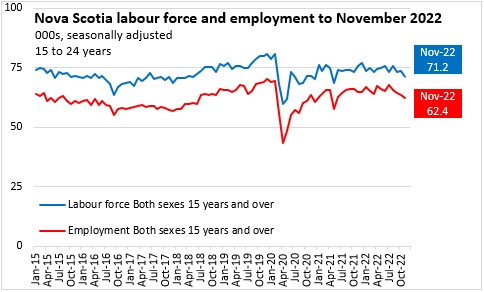
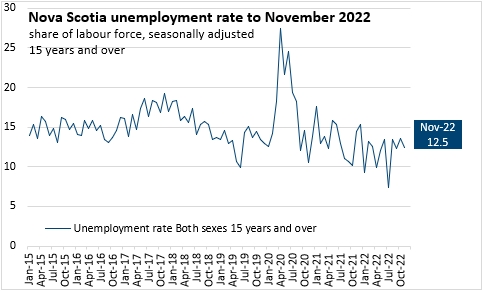
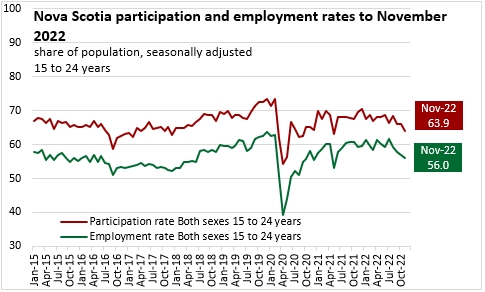
The population aged 25-54 makes up the largest part of the labour force. In the core age group, employment increased by 2,900 (+1.0%) and the labour force increased by 2,600 (+0.8%). Because employment increased faster than labour force, the core aged unemployment rate decreased 0.1 percentage points to 5.0% in November. The core aged participation rate rose by 0.6 percentage points to 87.1% while the core aged employment rate increased 0.6 percentage points to 82.7%.
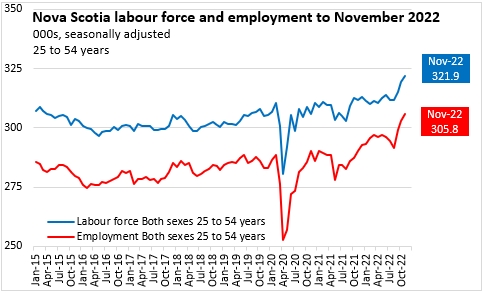
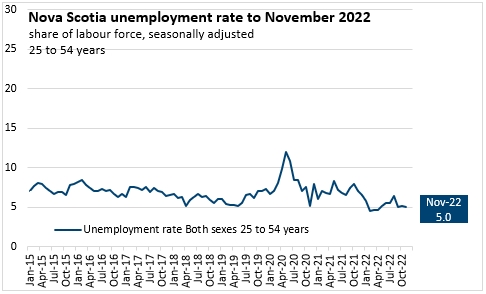

Older workers (aged 55+) reported a decrease in labour force (-2,500 or -2.0%) while employment was down (-200 or -0.2%). With labour force declining faster than employment, the older worker unemployment rate decreased 1.7 percentage points to 5.1%. The older worker participation rate was down 0.7 percentage points to 32.7% and the employment rate for older workers was unchanged at 31.1%.

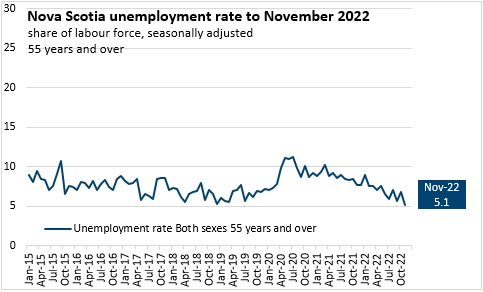

Males and Females (Ages 15+, November 2022 vs October 2022, seasonally adjusted)
Monthly employment increased 2,000 (+0.8%) for males and fell by 400 (-0.2%) for females. Labour force contracted for both males (-1,200 or -0.5%) and females (-900 or -0.4%).
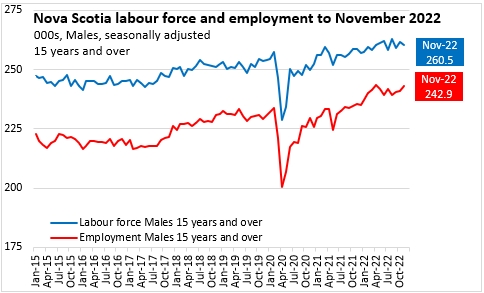
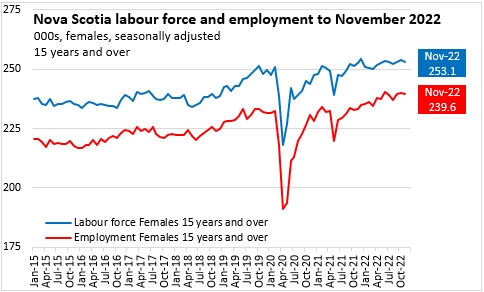
Both male and female unemployment rates fell. For males, employment gain and labour force contraction reduced the unemployment rate by 1.2 percentage points to 6.7%. For females, the contraction in labour force was faster than the decline in employment, reducing the female unemployment rate by 0.2 percentage points to 5.3%.

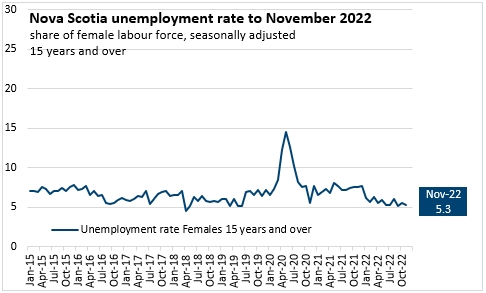
Male participation rates decreased by 0.4 percentage points to 63.4% while female participation rates dropped 0.3 percentage points to 57.7%. Male employment rates were up 0.4 percentage points to 59.1% while female employment rates decreased 0.1 percentage points to 54.7%.
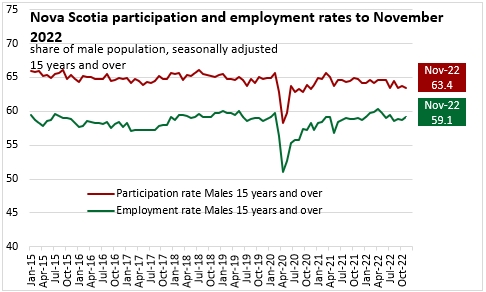
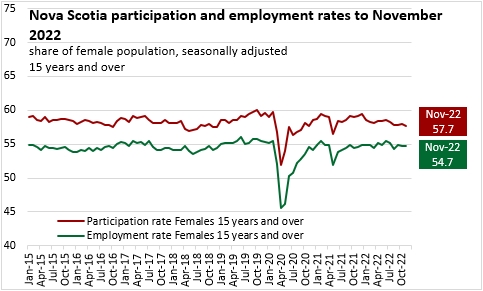
Overall, last month's employment and labour force growth was among core-aged workers and males. There were declines in employment for youth, women and older workers. Labour force was up only for those aged 25-54, with notable declines in labour force for those aged 15-24 and 55+.

Age and sex cohorts (November 2022 vs November 2021, seasonally adjusted)
Compared with November 2021, the latest month's labour force growth was concentrated among core aged workers (whose population is also growing faster than others). Youth and older workers both reported declining labour force, despite rising populations. Employment gains over the last year also concentrated among core aged workers with a small increase in older workers and a decline in youth employment. Unemployment was down for all cohorts. With population growing faster than labour force, the numbers not in the labour force increased for all cohorts.
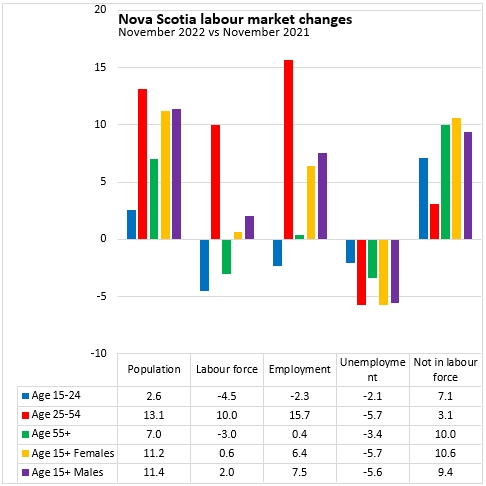
Age and sex cohorts (January-November 2022 vs January-November 2021, seasonally adjusted)
On average over the first eleven months of 2022, employment and labour force gains were reported in each age cohort, though growth of employment and labour force among youth was more modest.

Class of Worker (November 2022 vs October 2022, seasonally adjusted)
The November 2022 employment change reflected an increase in private sector workers (+3,400 or +1.1%) offset by contractions for public sector workers (-200 or -0.2%) and the self-employed (-1,600 or -2.7%).

Class of Worker (November 2022 vs November 2021, seasonally adjusted)
Compared to November 2021, there were gains in employment for private sector workers (+12,900 or +4.5%), public sector workers (+5,300 or +4.4%) while self employment was down (-4,300 or -7.0%).
Class of Worker (January-November 2022 vs January-November 2021, seasonally adjusted)
Compared with the first eleven months of 2021, there were gains in employment for all classes of workers during January to November of 2022: private sector workers (+10,700 or +3.8%), public sector workers (+4,900 or +4.1%) and self employment (+100 or +0.2%).
Industry of Employment (November 2022 vs October 2022, seasonally adjusted)
The employment change from October to November reflected notable employment increases in business support (including call centres), wholesale/retail, public administration and personal/repair services. These gains were offset by sizeable declines in construction, finance/insurance/real estate and accommodation/food services.
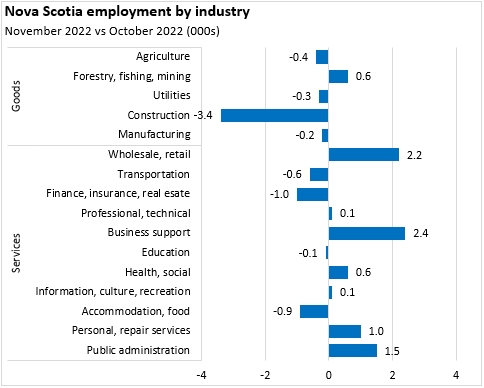
Industry of Employment (November 2022 vs November 2021, seasonally adjusted)
Over the last 12 months, employment has risen most sharply for forestry/fishing/mining, construction, manufacturing, finance/insurance/real estate, education, health/social (including daycare), information/culture/recreation, accommodation/food services and public administration. There were notable employment losses in transportation/warehousing, wholesale, retail, utilities and agriculture.
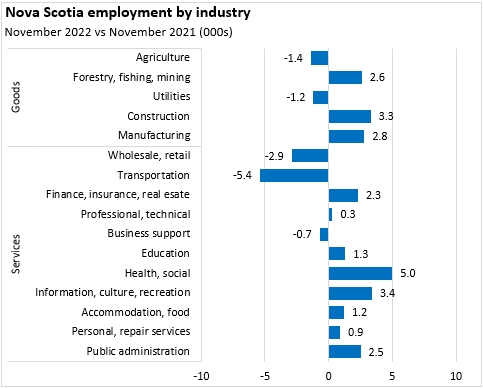
Industry of Employment (January-November 2022 vs January-November 2021, seasonally adjusted)
On average over the first eleven months of 2022 (compared with the same period last year), most industries reported employment gains. The increases in year-to-date average employment were largest for construction, professional/technical services, and health/social (including daycare) . Only agriculture, forestry/fishing/mining, utilities, wholesale/retail and transportation/warehousing reported declining employment on average in 2022.

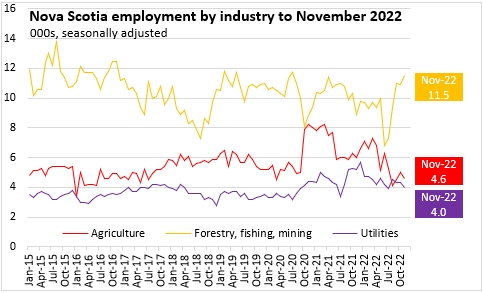
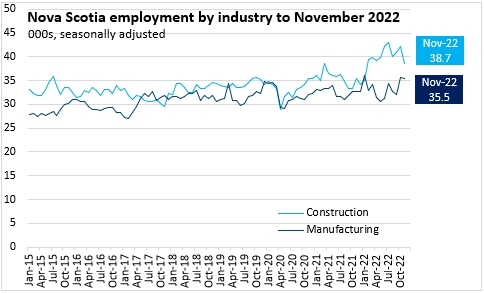
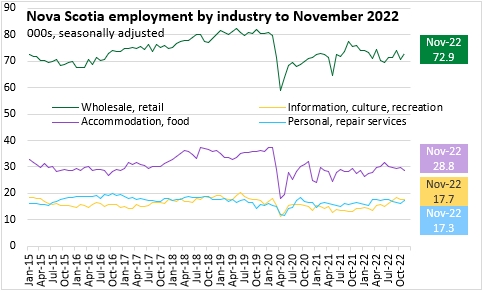
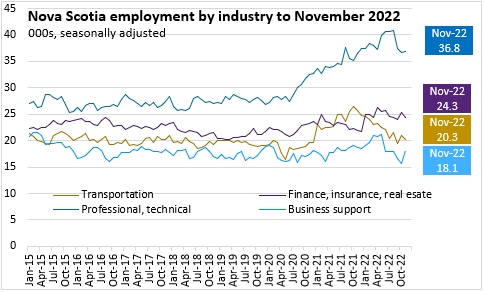
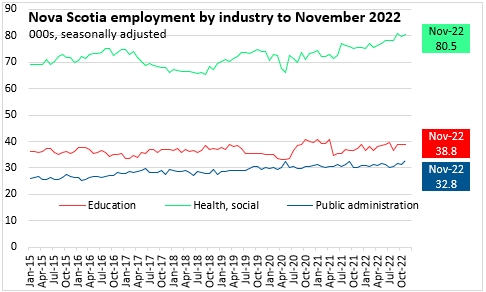
Hours worked and employment (January-November 2022 vs January-November 2021, unadjusted)
Changes in unadjusted hours worked show different variations than changes in seasonally adjusted employment (comparing the average over the first eleven months of 2022 with the same period in 2021). Overall employment was up by 3.4% while hours were up by 3.8%.
For most industries, changes in hours were similar to changes in employment. The exceptions were in agriculture (where there were larger decline in employment than hours worked) and personal/repair services (where hours worked increased substantially faster than employment).

Average weekly earnings (unadjusted, both full time and part time, January-November 2022 vs January-November 2021)
Average weekly earnings increased by 4.8% from January-November 2021 to January-November 2022. Earnings were up by across most industries, with the exceptions of information/culture/recreation. The fastest gains in average weekly earnings were in forestry/fishing/mining, professional and technical services and business support (which includes call centres).
The average increase in Nova Scotia's all items consumer price index was 7.4% through the first ten months of 2022, compared against the same months of 2021.

Average weekly earnings across all employees were $1,005.80 in November 2022. The highest average weekly earnings (both full and part time employees) were reported in professional/technical services, public administration and utilities. The lowest average weekly earnings were in accommodation/food services, business support/call centres and wholesale/retail trade.
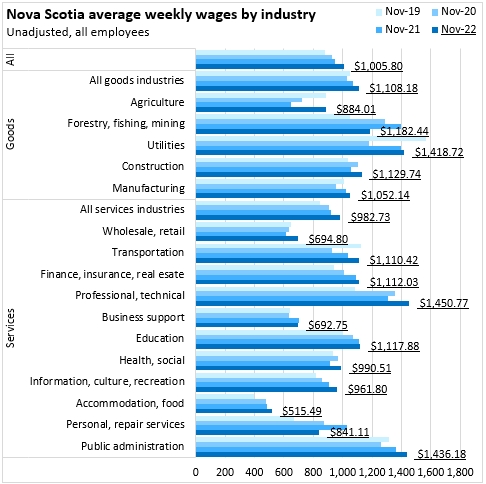
Regions (November 2022 vs November 2021, unadjusted 3 month moving average)
Compared with November 2021, employment and labour force each increased in Halifax, Southern Nova Scotia and the Annapolis Valley while labour force and employment each decreased in the North Shore and Cape Breton economic regions.
Unemployment rates declined in all regions from November 2021 to November 2022. In Halifax, Southern Nova Scotia and the Annapolis Valley employment gains outpaced the labour force change. In Cape Breton and the North Shore economic regions the fall in labour force was faster than the decline in employment.
Participation rates were up only in the Annapolis Valley and Southern Nova Scotia economic region. Employment rates were up in the Annapolis Valley, Southern Nova Scotia and Halifax.
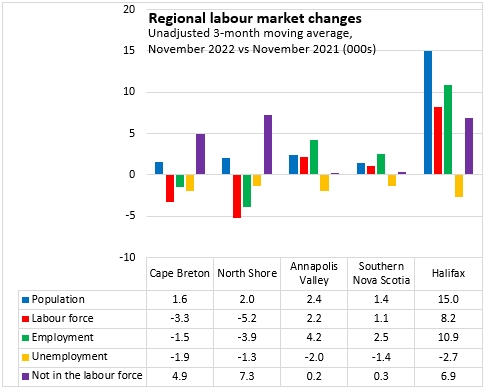

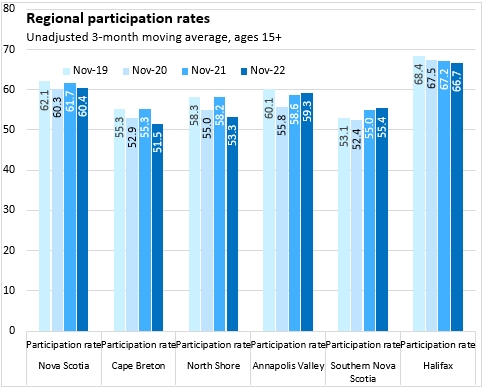
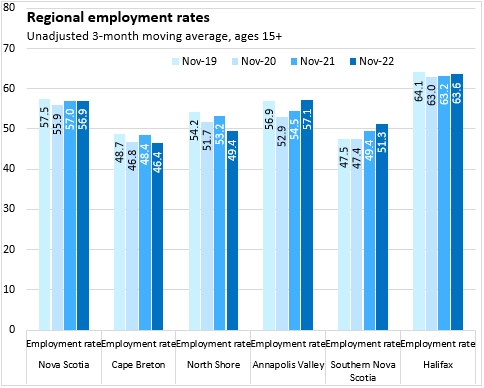
Regions (January-November 2022 vs January-November 2021, unadjusted 3 month moving average)
Comparing the average over the first eleven months of 2022 with the same months of 2021, labour force was down for the North Shore and Southern Nova Scotia economic regions. Labour force grew in Cape Breton, the Annapolis Valley and Halifax. Employment was up for Cape Breton, the Annapolis Valley and Halifax while there were declines in the North Shore and Southern Nova Scotia regions.
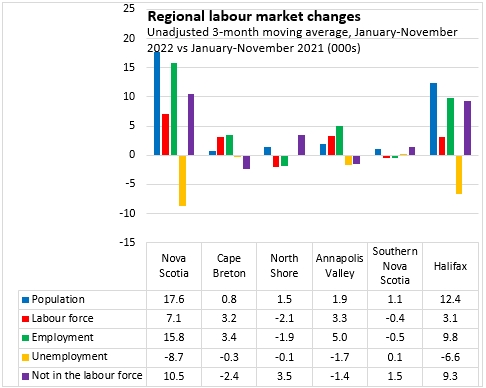
Provincial Comparisons (November 2022 vs October 2022, seasonally adjusted)
Canada's employment increased by 10,100 (+0.1%) from October to November, the third consecutive increase after three months of declines. Quebec reported the largest percentage employment increase.
The labour force decreased by 0.1% for Canada with declines in seven provinces. Only New Brunswick, Quebec and Alberta reported rising labour force. The largest decreases in labour force were reported in Newfoundland and Labrador and Manitoba.
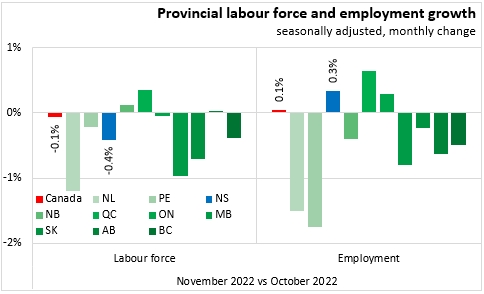
Provincial Comparisons (November 2022 vs November 2021, seasonally adjusted)
Compared with November 2021, Nova Scotia's employment was up 2.9% while labour force expanded by 0.5%. National employment was up 1.9% while labour force increased by 0.8%. All provinces reported employment and labour force gains over this period. The fastest growth rates for both employment and labour force were in Alberta (Newfoundland and Labrador had similar growth in labour force to Alberta). Manitoba reported the smallest growth in employment while British Columbia reported the least growth in labour force.

The national unemployment rate was 5.1% in November 2022, down 0.1 percentage points from October 2022 and down from 6.1% in November 2021. Saskatchewan and Quebec had the lowest unemployment rates while Newfoundland and Labrador reported the highest unemployment rate.
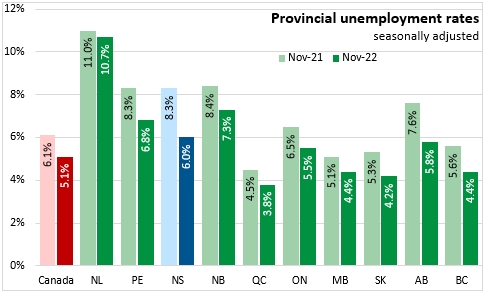
The national participation rate was 64.8% in November 2022. The highest participation rates were in Alberta and Saskatchewan while the lowest was in Newfoundland and Labrador.
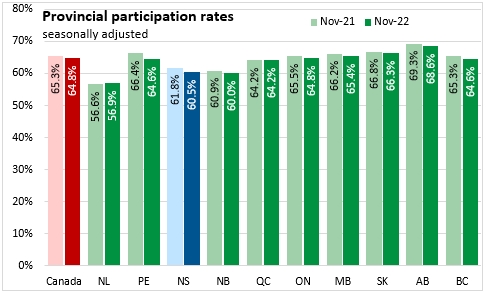
The national employment rate was 61.5% in November 2022. Alberta reported the highest employment rate while Newfoundland and Labrador reported the lowest.
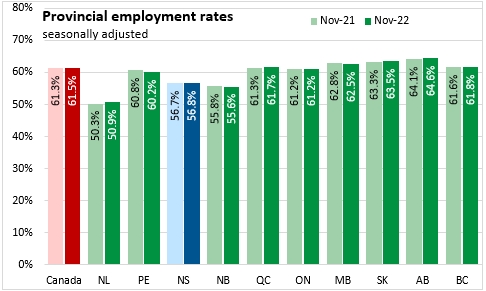
Census Metropolitan Areas (November 2022, seasonally adjusted 3 month moving average)
The Halifax unemployment rate was 5.2% in the seasonally adjusted November 2022 three month moving average. This was just above the national average, but lower than in the rest of Nova Scotia (7.5%). In central and western provinces, unemployment rates in Census Metropolitan Areas are similar to or higher than unemployment rates outside CMAs. In the Atlantic Provinces unemployment rates are typically higher outside CMAs.
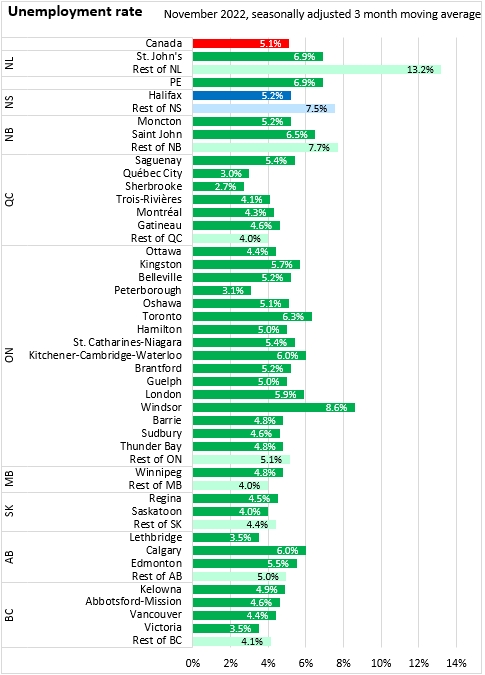
Halifax's participation rate was 66.7% in the seasonally adjusted November 2022 three month moving average while participation rates were 55.2% across the rest of the province.

Halifax reported an employment rate of 63.2% in the seasonally adjusted November 2022 three month moving average while the employment rate was 51.1% outside the city.
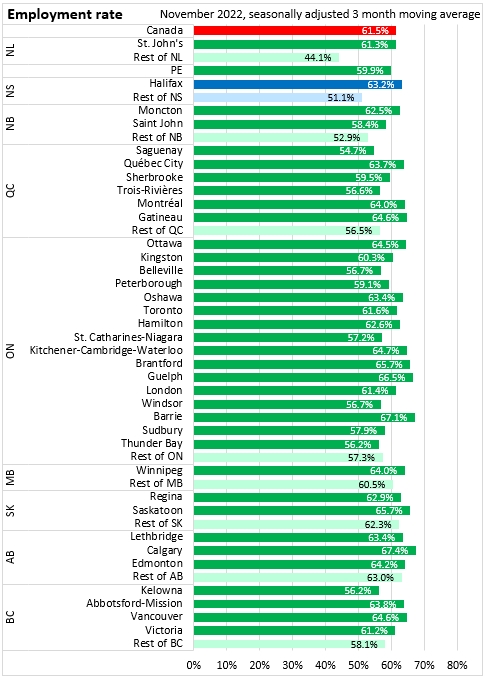
Sources: Statistics Canada. Table 14-10-0036-01 Actual hours worked by industry, monthly, unadjusted for seasonality; Table 14-10-0063-01 Employee wages by industry, monthly, unadjusted for seasonality; Table 14-10-0287-01 Labour force characteristics, monthly, seasonally adjusted and trend-cycle, last 5 months; Table 14-10-0380-01 Labour force characteristics, three-month moving average, seasonally adjusted; Table 14-10-0387-01 Labour force characteristics, three-month moving average, unadjusted for seasonality, last 5 months; Table 14-10-0355-01 Employment by industry, monthly, seasonally adjusted and unadjusted, and trend-cycle, last 5 months (x 1,000); Table 14-10-0288-01 Employment by class of worker, monthly, seasonally adjusted and unadjusted, last 5 months (x 1,000); Table: 14-10-0380-02 Labour force characteristics, three month moving average, seasonally adjusted (x 1,000)
<--- Return to Archive